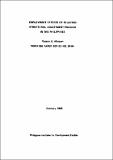| dc.contributor.author | Manasan, Rosario G. | |
| dc.coverage.spatial | Philippines | en_GB |
| dc.date.accessioned | 2014-04-04T11:01:18Z | |
| dc.date.available | 2014-04-04T11:01:18Z | |
| dc.date.issued | 1989 | |
| dc.identifier.citation | Manasan, R.G. (1989) Employment effects of selected structural adjustment policies in the Philippines. Working paper series, 8904. Manila : PIDS. | en_GB |
| dc.identifier.uri | https://opendocs.ids.ac.uk/opendocs/handle/20.500.12413/3741 | |
| dc.description.abstract | The experience of other countries that have implemented structural
adjustment policies in recent history points to the possibility that such
actions may yield negative employment and/or income distribution effects.
For instance, Yagci, Kamin and Rosenbaum (1985) cited the case of Turkey
where, during four years of structural adjustment "inflation fell from 103
percent in 1980 to 32 percent in 1983 and exports increased frcm $2.3B to
$5.7B in the same period but unemployment increased from 19.6 percent to
23.2 percent and real wages fell more than 10 percent in 1980-1983."
Similarly, Foxley (1981) noted that uneraplojnent sharply rose in Uruguay
and Chile, Brazil and Argentina as a result of adjustment policies
undertaken by these countries in the 1970s. Furthermore, existing studies
of the impact effects of selected components of the structural adjustment
policy package implemented by the Philippines indicate that they do have an
adverse influence on employment (Medalla 1986b). It cannot be denied
though that these works were largely based on partial equilibrium analysis
and may, therefore, be limited by the said approach. Orthodox economic
theory, for instance, tells us that structural adjustment policies should,
by "getting prices right" lead to a greater degree of efficiency and higher
economic growth.
Given this perspective, a re-examination in a general equilibrium
framework of the employment impact of the various structural adjustment
measures adopted in the Philippines in the 1980s is not only worthwhile but
timely as well. This study represents a small step in this direction.
Specifically, this paper will (1) review existing Philippine literature
on this area, (2) provide estimates of the employment/wage effects of (i)
tariff reform, (ii) BOI incentive changes, (iii) removal of export
taxes, (iv) financial liberalization and (v) exchange rate adjustment
based on simulation experiments using one or both of the PIDS-NEDA (1987)
macroeconometric model and Habito's (1986) computable general equilibrium
(CGE) model of the Philippine economy and (3) recommend new directions for
policy and future research in this area.
The decision to employ these two models as the basis of our analysis
is determined by purely pragmatic reasons. They represent the best
alternative specifications of an economy-wide model of the Philippines that
are available to this writer for purposes of policy analysis. | en_GB |
| dc.language.iso | en | en_GB |
| dc.publisher | Philippine Institute for Development Studies | en_GB |
| dc.relation.ispartofseries | PIDS working paper series;8904 | |
| dc.rights.uri | http://creativecommons.org/licenses/by-nc-nd/3.0/ | en_GB |
| dc.subject | Finance | en_GB |
| dc.subject | Work and Labour | en_GB |
| dc.title | Employment effects of selected structural adjustment policies in the Philippines | en_GB |
| dc.type | Series paper (non-IDS) | en_GB |
| dc.rights.holder | Philippine Institute for Development Studies | en_GB |
| dc.identifier.externaluri | http://www.pids.gov.ph/publications.php | en_GB |


